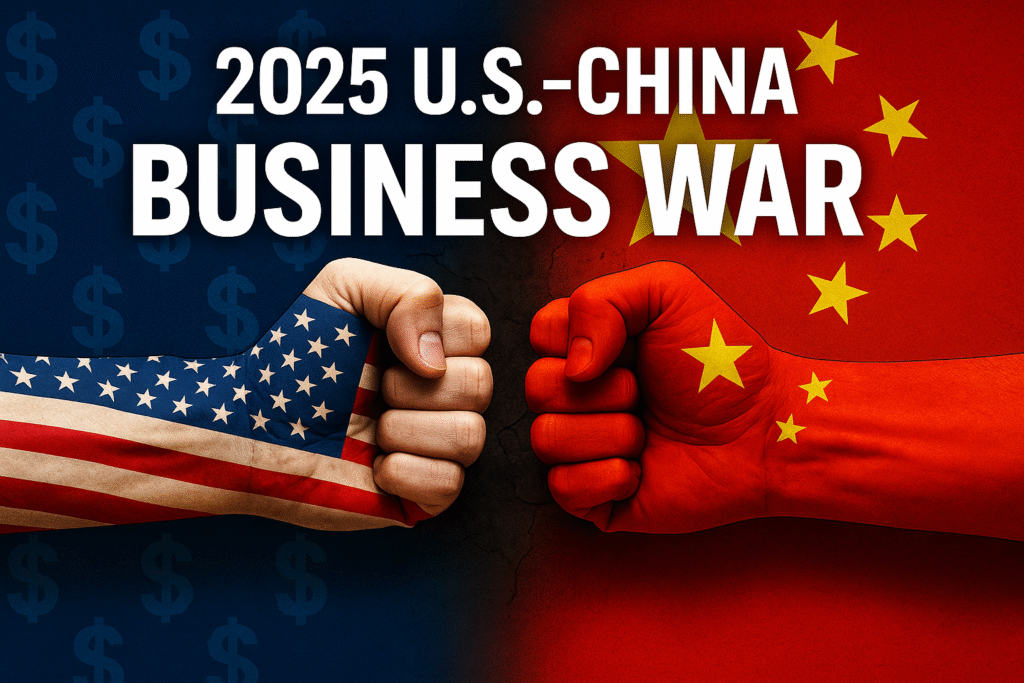In 2025, the US China Business War 2025 has entered a new and more intense phase, escalating the long-standing economic rivalry between the United States and China. What started as a trade dispute focused on tariffs has now evolved into a full-blown business war, affecting key industries such as technology, defense, shipping, and fashion. As both superpowers exert their economic influence, the consequences of the US-China Business War 2025 are being keenly felt across Europe and North America, reshaping global markets and trade dynamics.
This blog explores the key events, industries affected, and what European and American businesses should expect as this conflict intensifies.
🔥 What Triggered the US China Business War 2025?
The catalyst behind the current phase of the US-China economic conflict is a series of high-impact moves from the United States. The US government, under its current administration, introduced a set of aggressive economic policies targeting Chinese dominance in key industries:
-
Heavy port fees on Chinese-built or Chinese-owned vessels docking at American ports.
-
A new requirement that LNG (liquefied natural gas) in the US must be transported on US-built ships within the next three years.
-
Expanded export restrictions on advanced AI chips and semiconductors, directly affecting Chinese tech development.
These decisions are part of a broader plan to rebuild critical industries in the United States and reduce dependency on Chinese infrastructure and technology.
🇨🇳 China Responds with Tariffs and Technology Restrictions
China quickly responded with its own set of countermeasures, escalating the conflict further:
-
10% to 15% tariffs on key American exports such as crude oil, coal, and agricultural equipment.
-
An expanded ban on the export of critical minerals like gallium, germanium, and tungsten—materials essential for electronics, defense, and clean energy.
-
Placing major US defense companies such as Lockheed Martin and Raytheon Technologies on its export control list, limiting their access to Chinese-made parts and materials.
These moves have deepened uncertainty in global markets and prompted fears of long-term economic disruption.
🌍 How Europe and the US Are Being Affected

1. European Supply Chains Under Pressure
European industries, particularly in Germany, France, and the Netherlands, are heavily reliant on both American and Chinese trade. The escalating restrictions are creating bottlenecks, especially in:
-
Automotive manufacturing, where rare earths and high-tech components are vital.
-
Semiconductor and electronics production, which rely on stable imports from both nations.
-
Luxury fashion, as Chinese consumer spending slows due to uncertainty and economic retaliation.
Luxury brands like LVMH and Hermès have already reported slower growth in 2025, with Chinese consumer confidence dropping amid the growing conflict.
2. American Industries Facing Double Pressure
In the US, several industries are caught in the crossfire:
-
Agriculture: US farmers are losing one of their biggest markets as Chinese tariffs make exports uncompetitive.
-
Tech: Companies like Nvidia and AMD expect billions in lost revenue due to tightened chip export rules.
-
Defense: With China blocking rare earth exports, American arms manufacturers are scrambling for alternative supply chains.
What was once a tariff skirmish is now an all-encompassing business war, affecting everything from software to raw materials.
⚠️ The Bigger Picture: Global Economic Slowdown
According to the World Trade Organization, global trade volume is expected to decline by 0.2% in 2025, largely due to tensions between the United States and China. With supply chains disrupted, prices rising, and trade routes destabilized, businesses worldwide are bracing for turbulence.
Some analysts warn that prolonged economic confrontation could lead to regional trade blocs and the fragmentation of global trade as we know it.
Read More: ChatGPT vs DeepSeek: Who is Best?
📌 What Can Businesses in Europe and America Do?
-
Diversify suppliers and reduce dependency on single-source imports from China.
-
Strengthen regional partnerships within the EU or North America to ensure stability.
-
Invest in innovation and local manufacturing, especially in critical areas like semiconductors and clean energy.
-
Monitor regulatory changes closely, as export bans and tariffs may evolve monthly.
The new US China business war 2025 isn’t just about two countries—it’s about a global economic realignment. Companies that adapt quickly and strategically will be best positioned to survive and grow.




